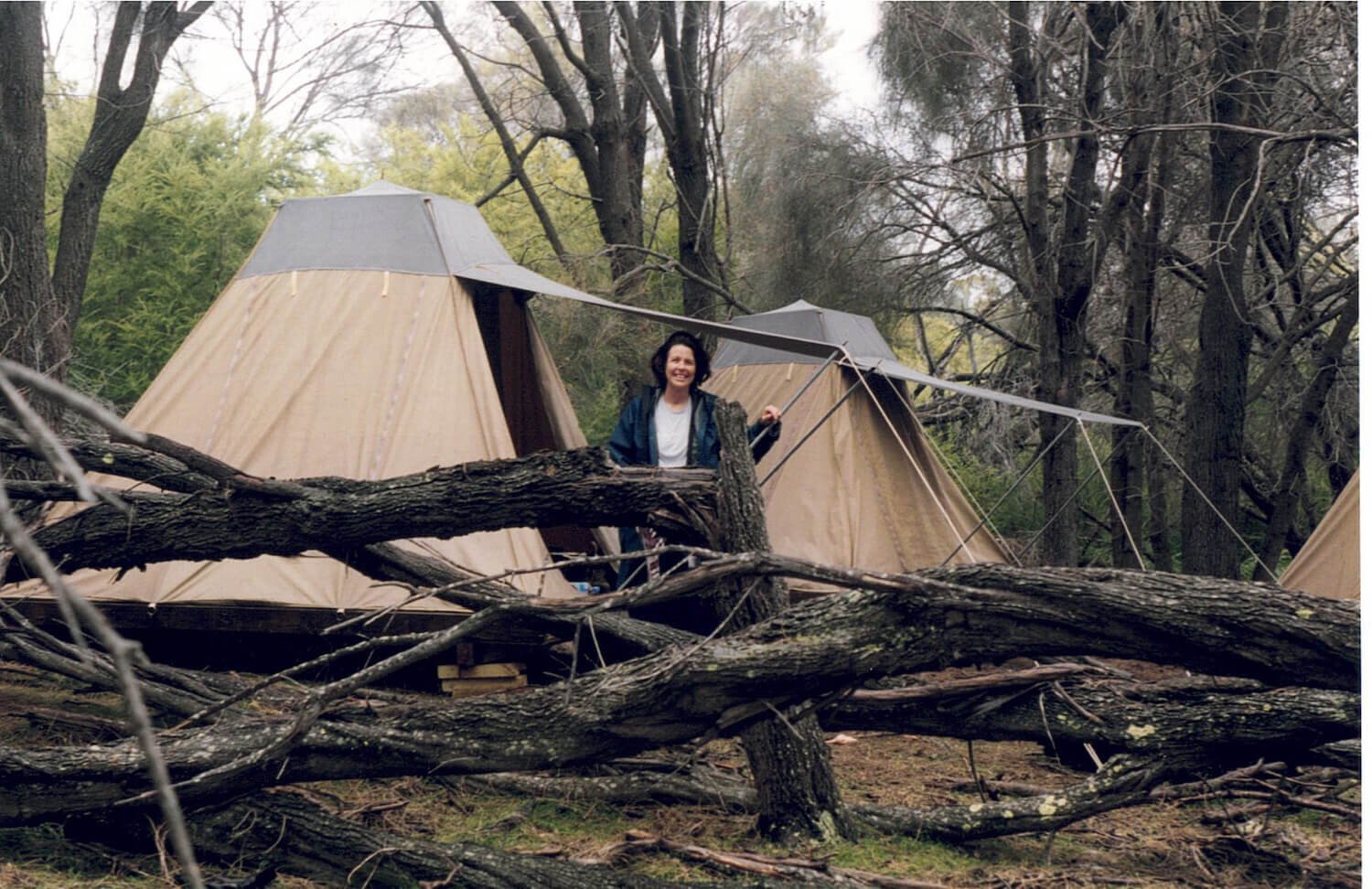Stand and Deliver
‘When we left, it looked as though there had never been a camp there.’ – Warren Partridge, former Freycinet Experience Walk guide
In the early years of Freycinet Experience Walk, guests spent the first two nights of their journey outdoors – comfortably ensconced in standing camps at Cooks Beach and Bluestone Bay – before spending their final evening at Friendly Beaches Lodge.
Freycinet Experience had obtained approval from the Tasmanian Parks and Wildlife Service to operate the standing camps – on the condition that the structures were dismantled at the end of each season, leaving no trace in the environment.
Joan Masterman standing in front of a standing camp
Ken Latona designed the demountable camps to suit the specific conditions of their locations. Each needed to be comfortable, functional, and secure. ‘Both camps were very much prototypes,’ he remembers.
The Cooks Beach camp included a communal dining and kitchen tent, cleverly designed storage, and individual sleeping tents placed on wooden platforms among the trees. Timber bed frames were assembled and set with comfortable mattresses and sleeping bags.
Bluestone Bay, described by Ken as being ‘a bit like a log cabin’, was set up on a disused quarry site to minimise environmental impact. A large timber platform and tent frame, made from leftover wood from Friendly Beaches Lodge, supported a single tent that included the kitchen and dining areas, with private partitioned sleeping quarters for guests. Both camps were equipped with portable toilets, and water was brought in or captured on site.
‘Ken had clearly put a lot of himself into the standing camps,’ says former guide Reuben Wells, now owner of precision agriculture company Ag Logic. ‘The way they were designed and built was quite clever and complex.’
Warren Partridge, another veteran Freycinet Experience guide who still works with the company, remembers the impact the standing camps had on a certain cohort of guests.
‘We’d get architects on the trips because that was the only way they could see Friendly Beaches Lodge. They’d comment on how much work had gone into those camps, particularly Bluestone Bay, and they'd be fascinated by the way it was put together.’
Setting up the camps took two teams several long, hard days. The components and camp furniture were stored at the Lodge off season in a shed specifically designed by architect James Jones. At the beginning of each season, the complex structures were unpacked and transported by boat to Cooks Beach and by road to Bluestone Bay.
‘We'd start at sunrise, load everything onto the back of the ute, drive to Coles Bay and load straight into the boat off the side of the jetty,’ remembers Warren. ‘We’d do several trips out to Cooks Beach and carry it all off the boat by hand. It was a lot of handling, and it was physically demanding, but it was a lot of fun as well.’
The boat transfer was made using the Naturaliste – a boat named after the ship captained by French explorer Nicolas Baudin on his 1802 exploration of the Freycinet Peninsula. The Naturaliste – an iconic craft much loved by Freycinet Experience guides – is still used to transport Freycinet Experience guests from Coles Bay to Schouten Island and the southern tip of the Peninsula on the first day of the walk.
Setting up and taking down the camps every year was laborious, but critical for the protection of the national park. The guides were meticulous about caring for the environment and removing every trace of their presence.
‘We would absolutely walk around like an emu hunt,’ says Warren. ‘We made sure there was nothing left behind, and when we left, it looked as though there'd never even been a camp there.’
Naturalist, conservationist, and guide, Peter Marmion – one of Freycinet Experience Walk’s first guides – was impressed with Joan’s sustainable approach to operating the camps.
‘Joan was setting a standard; the bar was so high. All the grey water and waste was collected, taken out, and properly disposed of. I always valued Joan’s approach to that because it was a lot of work and a lot of cost but that was the standard that she set.’
After two nights sleeping in nature, guests were welcomed to Friendly Beaches Lodge with comfortable beds, hot showers, and superb meals of local produce around the communal dining table. It was such a wonderful conclusion that many guests expressed a desire for more time at the Lodge. This, and the enormous logistical commitment of operating the camps, eventually led Joan to change Freycinet Experience Walk to a fully lodge-based experience.

